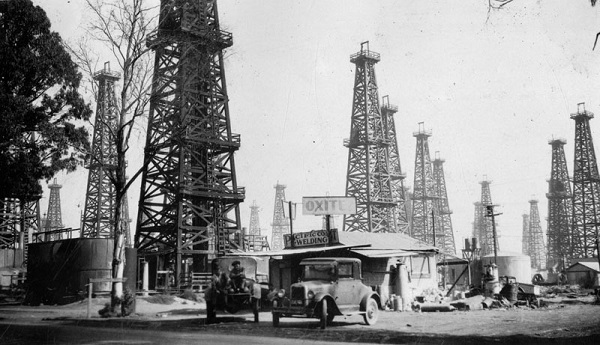
The Signal Hill oil discovery helped make California the source of one-quarter of the world’s entire oil output. “Porcupine Hill” was producing 260,000 barrels of oil a day by 1923 – and attracting a few shady characters.
In the summer of 1921, the Alamitos No. 1 oil exploratory well brought another spectacular California discovery – and the Signal Hill Oil Boom. As oil fever spreads, a wealthy real estate developer will take advantage of unwary investors.
Signal Hill soon became known as “Porcupine Hill” as exploration companies scrambled to the Long Beach field, 20 miles south of Los Angeles. By 1923, Long Beach was producing almost 260,000 barrels of oil every day. Investors looked for opportunities.
Successful Los Angeles real-estate developer John P. Mills formed his company in 1922. He incorporated it with three trusts and a charter for financing acquisition of properties in Long Beach and developing any oil and natural gas discovered on those properties. John P. Mills Company sold large numbers of $400 units over the next two years.
But there was no oil. Subsequent court documents would reveal it was ultimately “determined that the land was nonproductive of oil.” Then the struggle and litigation began.
The property was to be sold under the provisions of the trust agreement but with the consent of about 3,000 unit holders. The proceeds were to then be divided among the holders of the various units – but agreement proved impossible.
Although litigation and appeals dragged on until 1939, the John P. Mills Organization’s pursuit of oil had long since been abandoned. By then, Mills was far more notorious for his role in Los Angeles’ scandalous “Love Mart” affair of 1931 – in which local millionaires paid for underage girls, according to the Los Angeles Times.
Read more about California oil history in First California Oil Well, Discovering Los Angeles Oilfields and California Oil Seeps.
___________________________________________________________________________________
The stories of exploration and production companies joining petroleum booms (and avoiding busts) can be found updated in Is my Old Oil Stock worth Anything? The American Oil & Gas Historical Society preserves U.S. petroleum history. Please support this AOGHS.ORG energy education website. For membership information, contact bawells@aoghs.org. © 2018 Bruce A. Wells.

